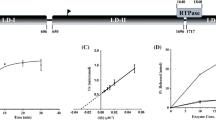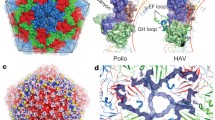Summary
Highly purified virulent poliovirus preparations harbour an endogenous protein kinase. Enzyme activity increases significantly upon purification of infectious virus particles from infected HeLa cells. Enzyme activity is stimulated by divalent cations. The substrate specificity and the degree of stimulation of the kinase are dependent on the nature of the divalent cations included in the assay. The preferred substrates for this kinase are the viral capsid proteins. Exogenously added proteins such as α-casein, phosvitin and protamine are also phosphorylated by the kinase. Moreover, these proteins enhance the phosphorylation of viral proteins. In the presence of Mg++ VP 2 and VP 0 are highly phosphorylated, while in the presence of Zn++ only VP 2 and VP 4, but not VP 0 or exogenous proteins are phosphorylated.
Poliovirus associated protein kinase exhibits optimal activity at pH 7.9 in the presence of 10mm Mg++. The Km for ATP is shown to be 40 µm. By testing different nucleotides as phosphate donors a specificity of the phosphorylation reaction for ATP is demonstrated.
Phosphoamino acid analysis of hydrolysates of the substrates phosphorylated in the presence of Mg++ by thin layer electrochromatography and HPLC yielded phosphoserine and phosphothreonine from viral capsid proteins while hydrolysates of protamine yield only phosphoserine.
Destabilization of the viral capsid, e.g. by preincubation at 42° C for 20 minutes results in a stimulation of kinase activity. Moreover, phosphorylation of the poliovirus capsid proteins itself results in destabilization of the viral capsid. These findings suggest that phosphorylation of the viral coat proteins triggers or enhances the uncoating of poliovirus leading to the release of viral RNA.
Similar content being viewed by others
References
Akusjarvi G, Philipson L, Petterson V (1978) A protein kinase associated with adenovirus type 2. Virology 87: 276–286
Blue WT, Stobbs DG (1981) Isolation of a protein kinase induced by herpes simplex virus type I. J Gen Virol 38: 383–388
Cajean-Feroldi C, Loeb J, Meguenni S, Girard M (1981) Protein kinase associated with the adenovirus single-stranded DNA-binding protein. Eur J Biochem 120: 79–87
Caplen HS, Holowczak JA (1983) Some enzymatic activities associated with purified parapoxvirions. J Virol 46: 384–393
Feitelson MA, Marion PL, Robinson WS (1982) Characterization of the protein kinase reaction associated with ground squirrel hepatitis virus and hepatitis B virus. J Virol 42: 741–748
Flügel RM, Darai G (1982) Protein kinase and specific phosphate acceptor proteins associated with tupaia herpes virus. J Virol 42: 410–414
Greco WR, Priore RL, Sharma M, Korytnyk W (1982) Rosfit: an enzyme kinetics nonlinear regression curve fitting package for a microcomputer. Comp Biomed Res 15: 39–45
Grimmel M, Zibirre R, Koch G (1983) Fluorescence spectrophotometric study of structural alterations in the capsid of poliovirus. Arch Virol 78: 191–201
Grubman MJ, Baxt B, La Torre JL, Bachrach HL (1981) Identification of a protein kinase activity in purified foot-and-mouth disease virus. J Virol 39: 455–462
Grubman MJ (1982) Further characterization of a protein kinase from foot-and-mouth disease virus. J Virol 44: 1102–1105
Hogle JM, Chow M, Filman DJ (1985) Three-dimensional structure of poliovirus at 2.9 A resolution. Science 229: 1358–1365
Howard CR, Buchmeier MJ (1983) A protein kinase activity in lymphotic choriomeningitis virus and identification of the phosphorylated product using monoclonal antibody. Virology 126: 538–547
Hunter T, Cooper JA (1985) Protein-tyrosine kinases. Ann Rev Biochem 54: 897–930
Imblum RL, Wagner RR (1974) Protein kinase and phosphoproteins of vesicular stomatitis virus. J Virol 13: 113–124
Kabus HP, Koch G (1982) Quantitative determination of amino acids in tissue culture cells by high performance liquid chromatography. Biochem Biophys Res Commun 108: 783–790
Kamata T, Kazutaka T, Hinuma Y, Watanabe Y (1981) Protein kinase activity associated with Epstein-Barr virus-determined nuclear antigen. Virology 113: 512–520
Koch G, Quintell N, Bishop J (1966) An agar cell suspension plaque assay. Biochem Biophys Res Commun 24: 304–309
Koch F, Koch G (1985) The molecular biology of poliovirus. Springer, Wien New York
Krebs EG, Beavo JA (1979) Phosphorylation and dephosphorylation of enzymes. Ann Rev Biochem 48: 923–959
Laemmli UK (1970) Cleavage of structural proteins during the assembly of the head of bacteriophage T4. Nature 227: 680–685
Martensen TM, Levine RL (1983) Base hydrolysis and amino acid analysis for phosphotyrosine in proteins. Meth Enzym 99: 402–405
Martin GS, Radke K, Carter C, Moss P, Dehazya P, Gilmore T (1984) The role of protein phosphorylation at tyrosine in transformation and mitogenesis. J Cell Physiol [Suppl] 3: 139–149
Michelson S, Tardy-Panit M, Barzu O (1985) Catalytic properties of a human cytomegalovirus-induced protein kinase. Eur J Biochem 149: 393–399
Mölling K, Heimann B, Beimling P, Rapp U, Sander T (1984) Serine and threonine specific protein kinase activities of purified gag-mil and gag-raf proteins. Nature 312: 558–561
Ochoa S (1983) Regulation of protein synthesis initiation in eucaryotes. Arch Biochem Biophys 223: 325–349
Pike LJ, Kuenzel EA, Casnellie YE, Krebs EG (1984) A comparison of the insulin—and epidermal growth factor—stimulated protein kinases from human placenta. J Biol Chem 259: 9913–9921
Racker E, Abdel-Ghany M, Sherill K, Riegler C, Blair EA (1984) New protein kinase from plasma membrane of Ehrlich ascites tumor cells activated by natural polypeptides. Proc Natl Acad Sci USA 81: 4250–4254
Roby C, Gibson W (1986) Characterization of phosphoproteins and protein kinase activity of virions, noninfectious enveloped particles, and dense bodies of human cytomegalovirus. J Virol 59: 714–727
Schärli CE, Koch G (1984) Protein kinase activity in purified poliovirus particles and empty viral capsid preparations. J Gen Virol 65: 129–139
Steiner AW, Helander ER, Fujitaki JM, Smith LS, Smith RA (1980) High performance liquid chromatography of acid stable and acid labile phosphoamino acids. J Chromat 202: 263–269
Stevely WS, Katan M, Stirling V, Smith G, Leader DP (1985) Protein kinase activities associated with the virions of pseudorabies and herpes simplex virus. J Gen Virol 66: 661–673
Strand M, August JT (1971) Protein kinase and phosphate acceptor proteins in rauscher murine leukemia virus. Nat N Biol 233, 137–140
Tsuzuki J, Luftig RB (1985) Evidence for the ubiquitous presence of a protein kinase in human adenovirus capable of preferentially phosphorylating capsid protein III a. Intervirology 23: 90–96
Villereal ML, Cook JS (1977) Role of the membrane potential in serum stimulated uptake of amino acid in a diploid human fibroblast. J Supramol Struct 6: 179–189
Vogel S, Freist W, Hoppe J (1986) Assignment of conserved amino acid residues to the ATP site in the protein kinase domain of the receptor for epidermal growth factor. Eur J Biochem 154: 529–532
Author information
Authors and Affiliations
Additional information
With 6 Figures
Rights and permissions
About this article
Cite this article
Lackmann, M., Ueckermann, C., Engelmann, K. et al. Properties of poliovirus associated protein kinase. Archives of Virology 95, 1–16 (1987). https://doi.org/10.1007/BF01311330
Received:
Accepted:
Issue Date:
DOI: https://doi.org/10.1007/BF01311330




